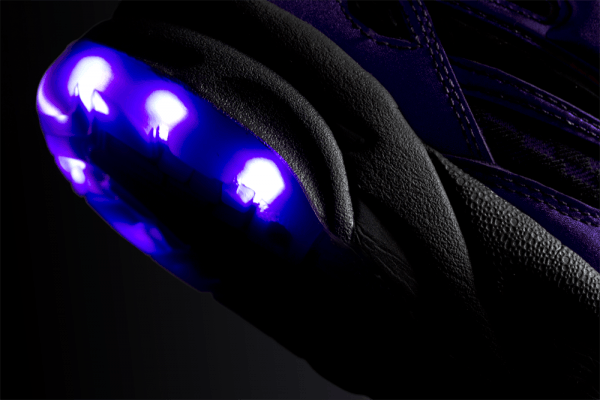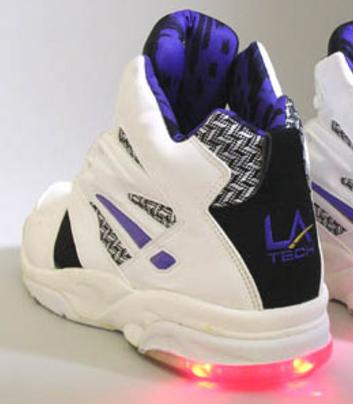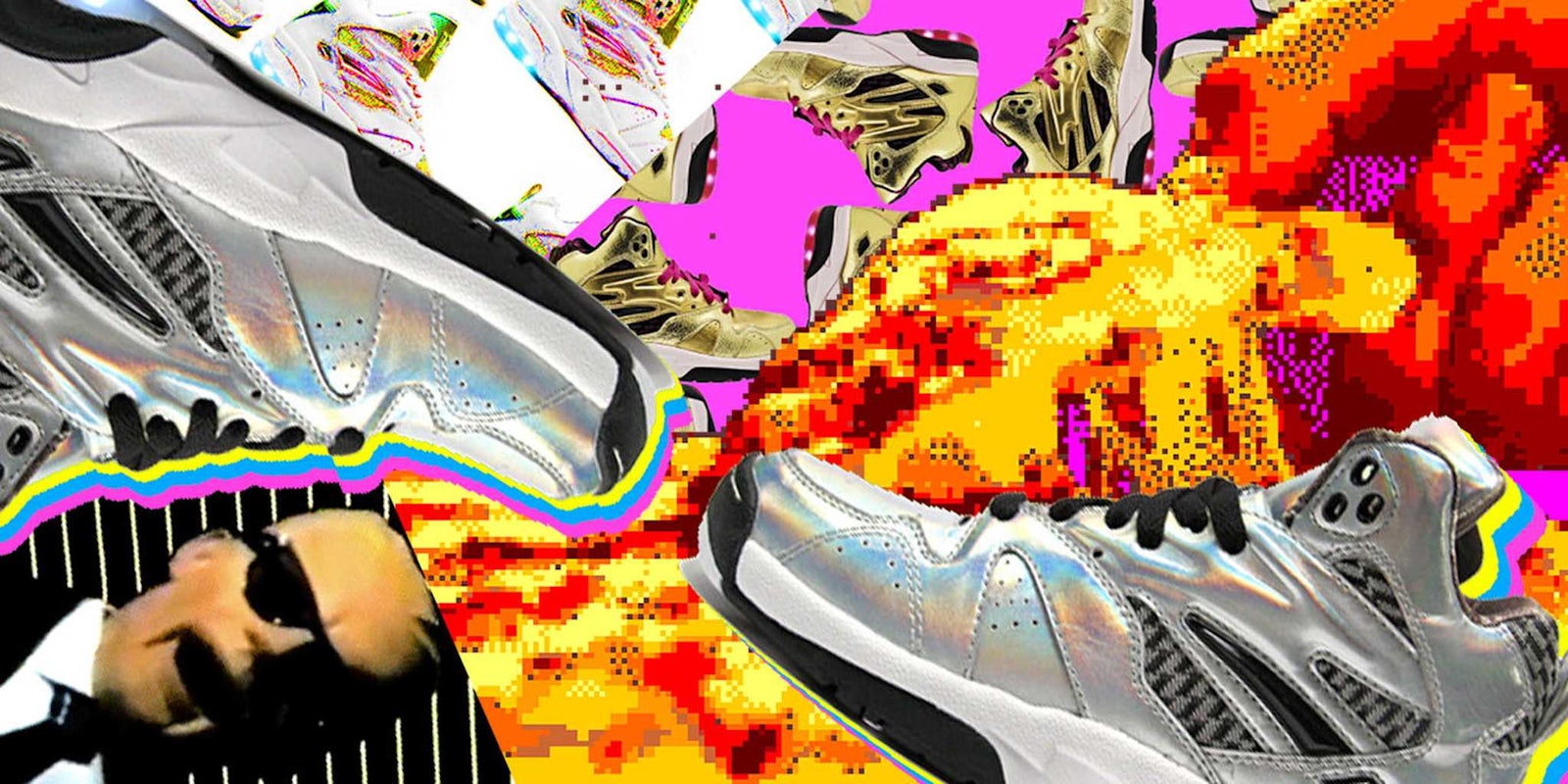In 1992, there were two things you needed if you were between the ages of eight and 14. First, you needed a Super Mario Brothers 3 watch—or, at the very least, have a very convincing tale about how you’re definitely getting one for your next birthday—and more important, you absolutely had to have a pair of L.A. Lights.
Back then, L.A. Gear’s light-up kids shoes were the status symbol on playgrounds and in classrooms across the United States. If your shoes didn’t flash brilliantly as you strolled down a hallway, you wished they did, and there was a great chance that your friends made you feel like a lesser human because of it.
Along with the aforementioned wrist-worn Nintendo accessory, L.A. Lights were one of the first must-have pieces of wearable tech for kids, and they’re starting to make a comeback.
But L.A. Gear’s beginnings were considerably less eye-catching.

Photo via L.A. Gear
Robert Greenberg, who would later go on to found Sketchers, started L.A. Gear in 1979 as an upscale women’s clothing retailer.
As sales of the brightly colored women’s shoes spiked, the company began offering men’s and children’s shoes and apparel in the mid-’80s, and by 1990, footwear was the main focus. L.A. Gear became a popular name in men’s athletic shoes and scored endorsements from major sports celebrities and college basketball teams who agreed to show them off on the court.
The sports push worked well for a while, but eventually L.A. Gear’s skyrocketing popularity began to spell trouble on the quality front. In late 1990, pairs of L.A. Gear shoes worn by Marquette University basketball players quite literally disintegrated on the court, and once during a nationally televised game. This was the beginning of the end for L.A. Gear’s athletic credibility, but the company had a secret weapon in the form of L.A. Lights.
In 1992, L.A. Lights breathed new life into L.A. Gear in dramatic fashion. With deals at popular retailers like Foot Locker, the company was able to sell over 5 million pairs of the light-up shoes over a 12-month period shortly after the line’s debut. For a solid two years, lit-up shoes were the hottest thing in kids fashion.
Aside from the small LEDs embedded in the soles of each shoe, there was nothing particularly exciting about the shoes themselves. They were kids’ shoes of average quality, came in bright colors, and they made children absolutely insane with desire. Copycats were spawned, horrible TV commercials appeared on a regular basis, and L.A. Gear’s stock was riding high. It was your standard early ‘90s success story. And it was all about to fall apart.
Many analysts and businessmen who lost money on L.A. Gear during the mid-to-late 1990s attribute the fall of the company and its Lights line to the emergence of grunge culture and the general distaste many customers began to accumulate for the sparkly glitz of the previous decade. But that’s not the whole story.
Indeed, anything with an ‘80s aesthetic had a harder time finding a customer base in the mid-90s than it had previously, but many of the L.A. Gear’s offerings had continued to sell reasonably well. The LED-equipped Lights in particular had remained a hot item thanks to its focus on kids, who for the most part didn’t know or care that adult fashion was shifting. What really came back to bite the company was the poison—yes, the poison—being sold along with every pair of blinking shoes.
For the first two, most popular years of L.A. Lights sales, every pair contained a not-insignificant amount of mercury. The metal, which is liquid at room temperature and toxic to humans, was used in the small tilt switches that powered the built-in LEDs. With every step, the mercury in the switch completed a circuit and produced the blinking effect. It was an extremely reliable and long-lasting design, but it was also dangerous and added an unwanted legal angle to shoe-buying.
As parents became gradually more aware of what they were strapping on their children’s feet, states began to take action. Minnesota went so far as to ban sales and distribution of the shoes, and the company was forced to pay $70,000 to aid in disposal efforts, as well as set up its own mail-in recycling program that was completely free to consumers.
 Surprisingly, sales of the shoes remained strong despite the extremely negative press, but the company was forced remove the mercury and switch to pressure-sensitive switches that were far less precise and prone to issues. In many cases, the switch itself would remain stuck in the “on” position and burn the shoe’s battery out in a matter of hours.
Surprisingly, sales of the shoes remained strong despite the extremely negative press, but the company was forced remove the mercury and switch to pressure-sensitive switches that were far less precise and prone to issues. In many cases, the switch itself would remain stuck in the “on” position and burn the shoe’s battery out in a matter of hours.
As consumers began to catch on to the diminished quality of the lighting technology, L.A. Gear’s stock took a nosedive of epic proportions. The company entered a slump it was not able to recover from.
News agencies didn’t help things much, and many drummed up the mercury scare with lines like “How do you know if your kids are wearing shoes with mercury? There is no sure way to tell, says the manufacturer.” Parents weren’t too keen on strapping the potentially poisonous shoes on their kids feet for obvious reasons, and the last unique product L.A. Gear had to offer died an awkward, painful death.
After the company well and truly collapsed in 1998, the brand had a few unsuccessful comeback attempts, and almost always leaned heavily on the L.A. Lights for a hint of the magic it had in the early 1990s.
The most recent revival attempt is still chugging along slowly, with a website where you can order brand new L.A. Gear shoes, including Lights, in a variety of sizes for both kids and adults. But staying true to the trend of hamfisted execution the brand has experienced over the past two decades, the site itself is rather half-baked. There are video windows embedded on the site that don’t work, and entire sections of the site where shoes appear to be for sale but aren’t actually clickable.
Wearable tech has come a long way since 1992. Light-up shoes are no longer a hot item but a strange artifact of the past that has been copied and recopied by budget brands for well over a decade.
The L.A. Lights craze was an unpredictable success that gave an unstable brand a few more years to right the ship, but a history of poor decisions kept that fairytale ending out of reach. But to kids in the ‘90s who fell in love with them, they were much more than that. To them, the simple, silly, and potentially dangerous footwear was magical, and for most, their glowing shoes were the first gadgets they ever owned.
Photos via Giphy | Remix by Rob Price

